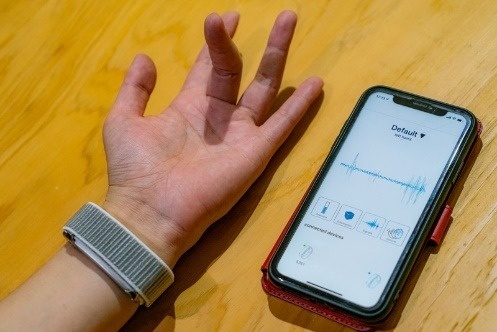Student Round Table Talk
“We want to actually experience and learn about not just researching technology but also business”
A team of 2nd-batch students formed in the lectures of the DII program applied for the Tongali Business Plan Contest and received a prize for its plan to develop software for patients with incurable diseases who have movement and speaking impairments. Sensors are used to detect the minute current flowing when trying to move the fingers, and the software converts the nerve signals into characters. The team feels strongly about their goal, which is to help those in need.
Team members
- HOSHINO Sena, Majoring in Materials Physics [Middle]
- LIN Fengchang, Majoring in Micro-Nano Mechanical Science and Engineering [Right]
- HIRANO Rui, Majoring in Information and Communication Engineering [Left]
Prize-winning business plan
“Communication tool using nerve signals for ALS patients”
Prize: Daiwa Securities Award

Q. What is your team, “open sesame,” like?

Lin
The idea for our team’s plan was presented by Mr. Hoshino during class.

Hoshino
I was in the same presentation group as Mr. Lin. We had an idea, but we couldn’t make it on our own. So, we asked Mr. Hirano, who has the skills we needed, to help us.

Hirano
When they asked me, I answered that I would love to join them, because I thought that the idea they presented in class was interesting. We divided the roles among the three of us and created a well-organized team. Mr. Hoshino is our team leader.

Lin
I test the hardware.

Hoshino
For example, while I have ideas on what we should do, Mr. Hirano and Mr. Lin also have their own ideas. The solutions are similar for all the ideas, but the approaches are very different. This generates more appropriate and unique ideas. In that sense, I believe it is a big advantage that all three of us major in different fields.
Q. Will you continue product development?

Hirano
We have demonstrated that this device can actually detect the movements of thumbs and index and middle fingers and convert them to enter characters. However, we have not conducted tests with patients.

Lin
Our goal is to make it available to ALS and other patients. ALS is a neurological disease, so we won’t know about the strength of the nerve signals until we try it. When the COVID-19 pandemic settles down, we will get in touch with patients and try to make it available for practical use.

Hirano
We would like to be able to tune it so that it can be implemented for any patient.

Hoshino
At present, eye input devices are the only communication tools for such patients. For patients, it is ideal for there to be various options for communication that are suitable for their physical conditions. The production of such a device will give patients choices and create price competition that will make product prices fair. This is what we are working for.
Q. What do you want to do in the future, and what do you want to cherish?

Hoshino
efore graduating and working for a company, I want to experience firsthand how a company is established and how a business is created. In addition to enhancing my value as a human resource, it will enable me to also actively engage with society.
So, I definitely want to establish a company in the DII program. I don’t know if we can establish one based on this idea, but I want to try to get as close as possible to it with this team. I want to learn from the experience. That is why I joined the DII program.

Lin
After graduation, I will basically work on product development as an engineer. But when developing products, market and customer needs have to be considered along with the technology. It takes knowledge of business to be able to do that. These kinds of attempts in the DII program feel a bit like a small company.
In addition to the kind of technology used to realize this product, we have to think about various other issues, like how many patients will actually purchase the product and how patients will be able to acquire the product, as well as the price and cost. These things are pretty important to think about, and I am enjoying it now.

Hirano
The DII program creates a favorable environment where students can develop their own outstanding features in an effective manner. The entrepreneurship education was especially good for me.
You have more options if you continue on to the doctoral course in the DII program. For example, there are paths for researchers and for the commercialization of research. With so many options, in the future it would be good to spend the first 5 or 10 years of my life working on things I like and commercializing them.
* HIRANO Rui was not able to come to the university on the day of the meeting and joined the round table talk remotely.



